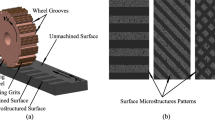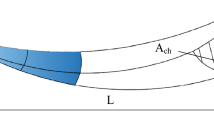Abstract
Grinding employs an abrasive product, usually a rotating wheel, which is brought into controlled contact with a workpiece surface. The grinding patterning process can be simulated using computer programming with specific user-defined parameters. To predict the surface pattern that will result from grinding with the grooved wheel, calculating the CAM parameters is very important. The intention of this research is to formulate CAM parameters for the generation of a surface pattern on a flat nominal surface by grinding with a wheel that has been prepared in a special way. A diamond dresser having a rounded tip is applied to prepare helical grooves on the conventional wheel’s surface. With the intention of extracting CAM parameters, a mathematical model is developed for a grinding patterning process, starting from the unit pattern geometry of the workpiece plate. The models are characterized by the process parameters of grinding patterning such as unit pattern geometry, dressing parameters, wheel geometry and grinding conditions, as well as work surface geometry. A computer program with a user interface is developed using Matlab according to the proposed mathematical model to predict surface pattern. In addition, several examples of simulation results of the 3D wheel geometry model and corresponding patterned surfaces have been displayed using the proposed CAM parameters as input. Formulated CAM parameters can be used to control the actual grinding process or predict the ground surface pattern.
Similar content being viewed by others
References
Malkin S, Guo S (2008) Grinding technology theory and applications of machining with abrasives. Ellis Horwood Limited, Chichester
Domala KV, Salisbury EJ, Moon KS, Sutherland JW (1995) A study of the three dimensional structure of a ground surface. Proc. Ist Int Machining and Grinding Conf 847-863
Suto T, Sata T (1981) Simulation of grinding process based on wheel surface characteristics. Bull Japan Soc Precis Eng 15(1):27–33
Chen X, Rowe WB (1996) Analysis and simulation of the grinding process, part I: generation of the grinding wheel surface. Int J Mach Tools Manufact 36(8):871–882
Bałasz B (2003) Analysis of shaping of workpiece surface topography and load of active abrasive grains in grinding process. Dissertation, Koszalin University of Technology
Stepien P (2006) Three basic types of regular surface texture generated by plunge grinding with the wheel having helical grooves. Adv Manuf Sci Technol 30(3):37–54
Stepien P (2007) Grinding forces in regular texture generation. Int J Mach Tools Manuf 47:2098–2110
Stepien P (2008) Mechanism of grinding wheel surface reproduction in regular surface texture generation. Surf Eng 24(3):219–225
Li X, Rong Y (2011) Framework of grinding process modeling and simulation based on microscopic interaction analysis. Robot Comput-Integr Manuf 27:471–478
Saravanan R, Sachithanandam M (2001) Genetic algorithm (GA) for multivariable surface grinding process optimisation using a multi-objective function model. Int J Adv Manuf Tech 17:330–338
Saravanan R, Asokan P, Sachidanandam M (2002) A multiobjective genetic algorithm (GA) approach for optimization of surface grinding operations. Int J Mach Tools and Manuf 42:1327–1334
Steffens K, Konig W (1983) Closed loop simulation of grinding. CIRP Ann Manuf Technol 32(1):255–259
Brinksmeier E, Aurich JC, Govekar E, Heinzel C, Hoffmeister H-W, Klocke F, Peters J, Rentsch R, Stephenson DJ, Uhlmann E, Weinert K, Wittmann M (2006) Advances in modeling and simulation of grinding processes. Ann CIRP 55(2):667–696
Stepien P (1989) Generation of regular patterns on ground surfaces. Ann CIRP 38(1):561–566
Gao W, Araki T, Kiyono S, Okazaki Y, Yamanaka M (2003) Precision nanofabrication and evaluation of a large area sinusoidal grid surface for a surface encoder. Precis Eng 27:289–298
Ike H (1996) Properties of metal sheets with 3-D designed surface microgeometry prepared by special rolls. J Mater Process Technol 60:363–368
Ike H, Plancak M (1998) Coining process as a means of controlling surface microgeometry. J Mater Process Technol 80–81:101–107
Pettersson U, Jacobson S (2006) Tribological texturing of steel surfaces with a novel diamond embossing tool technique. Tribol Int 39:695–700
Fornie’s E, Zaldo C, Albella JM (2005) Control of random texture of monocrystalline silicon cells by angle-resolved optical reflectance. Sol Energy Mater Sol Cells 87:583–593
Xi Z, Yang D, Que D (2003) Texturization of monocrystalline silicon with tribasic-sodium phosphate. Sol Energy Mater Sol Cells 77:255–263
Bulatov VP, Krasny VA, Schneider YG (1997) Basic of machining methods to yield wear- and fretting-resistive surfaces, having regular roughness patterns. Wear 208:132–137
Arola D, McCain ML, Kunaporn S, Ramulu M (2002) Waterjet and abrasive waterjet surface treatment of titanium: a comparison of surface texture and residual stress. Wear 249:943–950
Ramasawmy H, Blunt L (2004) Effect of EDM process parameters on 3D surface topography. J Mater Process Technol 148:155–164
Cheng X, Yang XH, Huang YM, Zheng GM, Li L (2014) Helical surface creation by wire electrical discharge machining for micro tools. Robot Comput Integr Manuf 30:287–294
Kovalchenko A, Ajayi O, Erdemir A, Fenske G, Etsion I (2005) The effect of laser surface texturing on transitions in lubrication regimes during unidirectional sliding contact. Tribol Int 38:219–225
Choo KL, Ogawa Y, Kanbargi G, Otra V, Raff LM, Komanduri R (2004) Micromachining of silicon by short-pulse laser ablation in air and under water. Mater Sci Eng, A 372:145–162
Du D, He YF, Sui B, Xiong LJ, Zhang H (2005) Laser texturing of rollers by pulsed Nd:YAG laser. J Mater Process Technol 161:456–461
Hong MH, Huang SM, Luk’yanchuk BS, Chong TC (2003) Laser assisted surface nanopatterning. Sens Actuators, A 108:69–74
Lee Y-C, Chen C-M, Wu C-Y (2005) A new excimer laser micromachining method for axially symmetric 3D microstructures with continuous surface profiles. Sens Actuators, A 117:349–355
Man HC, Zhang S, Cheng FT, Guo X (2005) Laser fabrication of porous surface layer on NiTi shape memory alloy. Mater Sci Eng, A 404:173–178
Chamorro LP, Arndt REA, Sotiropoulos F (2013) Drag reduction of large wind turbine blades through riblets: evaluation of riblet geometry and application strategies. Renew Energy 50:1095–1105
Denkena B, Köhler J, Wang B (2010) Manufacturing of functional riblet structures by profile grinding. CIRP J Manuf Sci Technol 3:14–26
Andersson P, Koskinen J, Varjus S, Gerbig Y, Haefke H, Georgiou S, Zhmud B, Buss W (2007) Micro-lubrication effect by laser-textured steel surfaces. Wear 262:369–379
Chakrabarti S, Paul S (2008) Numerical modeling of surface topography in superabrasive grinding. Int J Adv Manuf Technol 39:29–38
Kim H-C, Lee S-G (2012) Development of machining technology for micropatterns with large surface area. Int J Adv Manuf Technol 58:1261–1270. doi:10.1007/s00170-011-3544-7
Cao Y, Guan J, Li B, Chen X, Yang J, Gan C (2012) Modeling and simulation of grinding surface topography considering wheel vibration. Int J Adv Manuf Technol DOI. doi:10.1007/s00170-012-4378-7
Kim HC, Ko TJ (2012) Parametric modeling of a screw fabricated by turning. J Korean Soc Manuf Process Eng 11(6):62–68
Islam MM, Kim H, Ko T, Geometry modeling of screwed wheel dressed by rounded tool. Accepted to the Journal of the Chinese Society of Mechanical Engineers.
Kim H, Ko TJ (2014) Simulation of micro-patterns engraved by grinding process with screw shaped wheel. Simul Model Pract Theory 49:277–286
Author information
Authors and Affiliations
Corresponding author
Rights and permissions
About this article
Cite this article
Islam, M.M., Kim, H. & Ko, T. Formulating CAM parameters for surface patterning by grinding process based on unit pattern geometry. Int J Adv Manuf Technol 83, 595–609 (2016). https://doi.org/10.1007/s00170-015-7296-7
Received:
Accepted:
Published:
Issue Date:
DOI: https://doi.org/10.1007/s00170-015-7296-7




